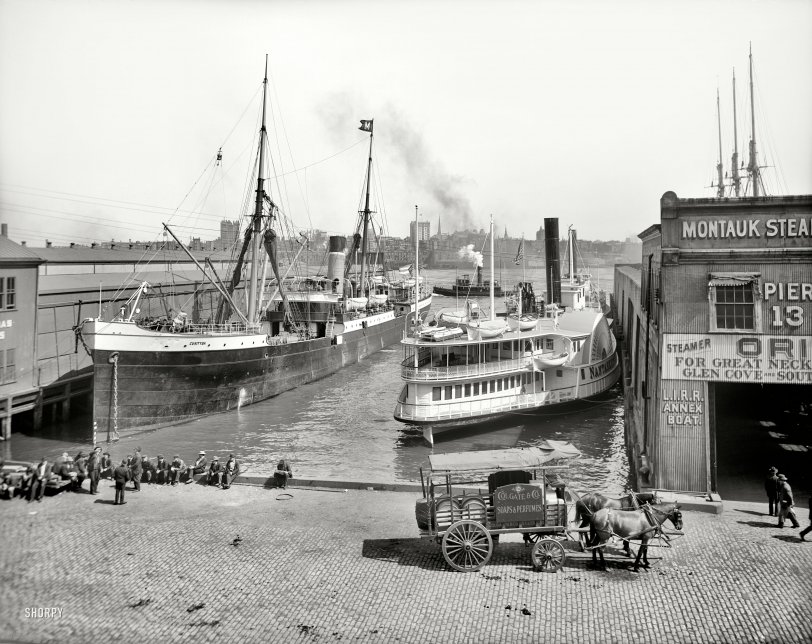


Framed or unframed, desk size to sofa size, printed by us in Arizona and Alabama since 2007. Explore now.
Shorpy is funded by you. Patreon contributors get an ad-free experience.
Learn more.

- Freeze Frame
- Texas Flyer wanted
- Just a Year Too Soon
- WWII -- Replacing men with women at the railroad crossing.
- Yes, Icing
- You kids drive me nuts!
- NOT An Easy Job
- I wonder
- Just add window boxes
- Icing Platform?
- Indiana Harbor Belt abides
- Freezing haze
- Corrections (for those who care)
- C&NW at Nelson
- Fallen Flags
- A dangerous job made worse
- Water Stop
- Passenger trains have right of way over freights?
- Coal
- Never ceases to amaze me.
- Still chuggin' (in model form)
- Great shot
- Westerly Breeze
- For the men, a trapeze
- Tickled
- Sense of loneliness ...
- 2 cents
- Charm City
- What an Outrage
- Brighton Park
Print Emporium
Pier Thirteen: 1905

New York circa 1905. "Piers at foot of Wall Street. Steamship Curityba and sidewheeler Nantasket." Not to mention that fine-looking Colgate wagon. 8x10 inch dry plate glass negative, Detroit Publishing Company. View full size.
re: Pier location anyone?
Should be approximately 4 blocks south. the pier numbers are generally equal to streets but things get a little weird in the financial district because it predates the street grid.
Munson steamer Curityba
Launched August 1887 at the Reiherstieg shipyard in Hamburg, Germany, for the Hamburg-Southamerican Steamship Company ("Hamburg-Süd"); sold 1890s to the Munson Line. Renamed LIBERIA in 1914 and MARYANNE in 1917. Breakup at Vigo, Spain, in 1921.
Not to be confused with another ship of the same name, originally the HOLSTEIN, sunk off Norway in 1942 by a Russian sub.
Alfred Charles Sam
Thanks for those links Mr. Dog. A truly fascinating episode in our history. Most surprising was to learn that many of the freed slaves involved had been the chattel of American Indians of the "Five Civilized Tribes".
In fact, as recently as last year the question of whether these Freedmen were citizens of the Cherokee Nation was being adjudicated. "Cherokee District Court Judge John Cripps ruled in favor of the plaintiffs in the Raymond Nash et al v. Cherokee Nation Registrar case, reinstating Cherokee Nation citizenship and enrollment to the Freedmen descendants."
The descendants of freed slaves may actually be Cherokees, though few seem to know or care. Their forefathers were the ones Chief Sam promised to return to their ancestral home in Africa.
A Few More Odd Features of Curityba
There is a forestaysail furled, visible just abaft the anchor davit. Steadying sails on steamers were definitely passe' by 1905.
Also, there's what looks like an anchor light, of the kind that was available until recently, hoisted partway up the fore topmast stay, in the same position used by yours truly on his own boats because that position provided a good arc of view. The anchor lights I used were battery powered but it looks like the one on Curityba is electric, with a wire running up the stay with attachments every few feet, very similar to hanks used to attach a sail to the stay. The downhaul attached to the light with a bridle is meant to hold it as close to vertical as possible, because the small Fresnel lenses used on those lights concentrated the light in a horizontal plane when the light was vertical. This anchor light deployed for use might be related to the port anchor being lowered partway; either the ship has just docked after spending considerable time at anchor, or the captain expects to have to anchor overnight rather than steaming away at once when he leaves the dock. Anchor lights are required only during the hours of darkness, at least by present day rules.
Maritime commerce in that time period ran at a more stately pace than it does today.
Colgate Wagon
Yes, the Colgate wagon is from the precursor to today's Colgate Palmolive. The Colgate factories were located directly across the Hudson in the Paulus Hook section of Jersey City on the waterfront, and occupied several blocks.
Colgate
The wagon says 'Colgate'. Could that be what is now Colgate Palmolive?
[Could be. - tterrace]
Pier Location
The caption says "Piers at foot of Wall Street." That current location at Wall and South Streets is a large pier serving several ferry lines, including the East River Ferry and the very popular Ikea Ferry to the store in Red Hook, Brooklyn.
Steamship Curityba History
Interesting history of the Steamship Curityba. A search of the name reveals she was very active, and there are several stories in the New York newspapers about her. Around 1914 she was sold to a consortium led by an African Chief, Alfred Charles Sam of the Akim Tribe, renamed "Liberia" and was to be used to "repatriate" 4-500 African Americans to Africa. Ultimately only about 60 made the trip, it failed miserably, and most returned to America. It appears the ship was abandoned in Africa because of its deteriorated condition. Here are a couple of links with more info.
Pier location anyone?
Does anyone know where Pier 13 was? Maybe near present day South Street Seaport, which is Pier 17?
Anchors Aweigh
Surprised to see the Curityba has dropped her anchor while tied up at the dock. Never heard of that being done - maybe they're just washing it?
Sign Painter's Nightmare
God bless whoever had to do the signage on the Pier 13 building. The corrugated ribs on the tin siding must have driven him crazy!
























On Shorpy:
Today’s Top 5